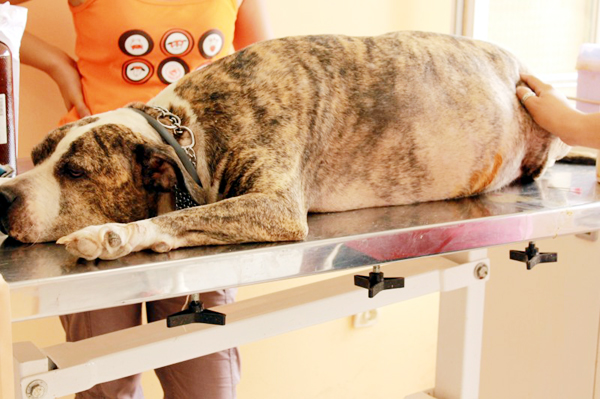Dr Varun Bassessar
Pyometra is an infection of the uterus in dogs and cats. It is relatively common, affecting approximately 25% of unspayed female dogs and cats. It is a serious condition which results in a veriety of clinical and pathological signs requiring emergency surgery to remove the infected uterus. While medical treatment is sometimes attempted for this condition, it is often ineffective, and can be dangerous.
Pyometra is an important disease to be aware of for any dog owner because of the sudden nature of the disease and the deadly consequences if left untreated. It has been compared to acute appendicitis in humans, because both are essentially empyemas within an abdorminal organ.
Symptoms
The most obvious symptom of open pyometra is discharge of pus from the vulva in a Female that has recently been in heat. However, symptoms of closed pyometra are less obvious. Symptoms of both types include vomiting, loss of appetite, depression, and increased drinking and urinating. Fever is seen in less than a third of female dogs with pyometra. Closed pyometra is a more serious condition than open pyometra not only because there is no outlet for the infection but also because a diagnosis of closed pyometra can easily be missed due to its insidious nature. Bloodwork may show dehydration and/or increased white blood cell count. X-rays will show an enlarged uterus, and ultrasoud will confirm the presence of a fluid filled uterus.
Cause
Pyometra is a result of hormonal and structural changes in the uterus lining. This can happen at any age, whether she has bred or not, and whether it is her 1st or 10th heat (although it becomes more common as the dog gets older). The main risk period for a female is for eight weeks after her peak standing heat (or estrous cycle) has ended. Normally during this period, the cervix, which was open during her heat, begins to close, and the inner lining begins to adapt back to normal. However, cystic hyperplasia of the endometrium (inner lining of the uterus)- known as cystic endometrial hyperplasia (CEH)- may occur at this time for some animals, as an inappropriate response toprogesterone.
Under these circumstance, bacteria (especially E coli) that have migrated from the vagina into the uterus find the environment favorable to growth, especially since progestone also causes mucus secretion, closes the cervix (preventing uterine drainage), and decreases uterine contractility. The condition of the cervix is a major factor in the severity of the condition.
* If the cervix is open, the infected material can leave the body, and this is far easier and safer to treat. This is known as open pyometra.
* If the cervix is fully closed, there is no discharge from the vulva, and like in appendicitis, the uterus may rupture and pus escapes into the abdomen, causing peritonitis and possible rapid death. This is known as closed pyometra.
Treatment
The most important aspect of treatment of pyometra is quick action to provide supportive care. Female dogs are often septic and in shock. Intravenous fluids and antibiotics should be given immediately. Once the female dog has been stabilized, then the treatment of choice is an emergency spay.
Surgical treatment
Spaying (ovariohysterectomy) completely and promptly removes the infection, prevents uterine rupture and peritonitis, and of course prevents recurrence, in most cases. Spayed animals do very rarely develop pyometra in the uterine stump. Even so, ovariohysterectomy is currently considered the most effective and safest treatment.
To conclude, E coli are the major bacterium leading to pyometra in canines but other organisms are equally important. Gentamicin should be the drug of choice and canine pyometra cases should be handled carefully as the E coli also represents a potential risk to human.
Trending Now
E-Paper


